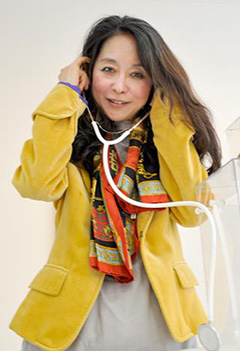
My main research areas are the art and dance of the United States in the 1960s, the period when contemporary art became established. What I do is scramble ideas between these areas, with a focus on the concept of the body. The traditional borders between different genres started becoming blurry around this period. We have seen things that are hard to wrap our heads around: Unprocessed objects that are neither paintings nor sculptures are presented as works of art; painters engage in various performances; dancers treat their bodies as art objects (and this can sometimes get confusing in class).
These days I do extensive research on various subjects simultaneously, such as postmodern dance (in particular, areas related to dance as a means of self-transformation or self-renunciation rather than self-expression), ancient elements surviving in contemporary art (postmodern neo-premodernism), and art as a means to adjust the environment. I am interested in things that got lost in the process of aesthetics emerging as a field of philosophy and, subsequently, art becoming established as an institution. I am also interested in movements aimed at restoring those lost things in various ways. I am drawn to these topics without being tied to specific fields of study, and I consider them in various contexts including not only art and culture centers such as museums and theaters, but also other forums like streets, the forest, and the home.
To be more specific, from the standpoint of children and elders who do not fit well in modern agent-based models, I am embarking on the study of how aesthetics and art theory can contribute in the present day to the restructuring of survivability studies, death and life studies, and techniques for a better life. My goal is to examine the significance of going back to rooting our lives in our natural bodies, to put concepts into practice as much as possible—in my own life, too—even if progress is gradual, and to share the result of my study with others in Japanese society after 3/11 disaster.
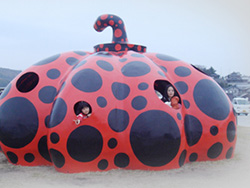
Background
When I was a student, I was restless. I moved from classical Greek (Platonic) philosophy to twentieth-century dance aesthetics and contemporary art. My interest further shifted to more peripheral activities including dance as healing or therapy, and “sandlot art” and “marginal art” in which people are active participants rather than passive appreciators of high art. My shifting interests left me quite surprised.
Turning point
At domestic and international academic conferences, I desperately presented different approaches along the lines of postmodernism in dance, restoration of the art of life, neo-premodernism, and “cleaning poiesis,” with a perspective from the margins. As I did it, I started to vaguely see a path that would connect my interests with my research. In particular, it was significant for me to be given the opportunity to explore the possibility of dance research that would extensively cover ideas from survivability studies and death and life studies, by participating in the 2011 Conference of the Japanese Society for Dance Research held at the Sainokuni Saitama Arts Theater and an international symposium held in Berlin in 2012.
Ignition
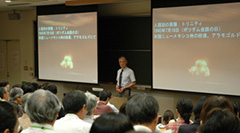
Academic seminar organized by the Faculty of Liberal Arts: Professor Hiroaki Koide
“The Accident at the Fukushima Nuclear Power Plant and Choosing a Way to Live,” October 1, 2012
The earthquake disaster and nuclear crisis ingrained in me the emptiness and danger of words that were endlessly mass-produced by “intelligent” experts who were isolated from the actual lives of people and who disguised themselves as neutral, transparent agent. Since then, I have been grappling with these issues both privately and publicly.
Wandering
Distressed by my weak methodology, a lack of time, and the fact that I am a natural-born escapist, I spend my days losing my sense of direction (which I have little to begin with) as I tackle a swirl of related subjects—somaesthetics put forth by Foucault and Shusterman; studies on somatic techniques, training methods, and discipline in Asia; shamanism; the history of performing arts (studies of Noh dance, in particular); and somatics in Europe and the United States.
Prospect
Although I’ve been trying to do better as a 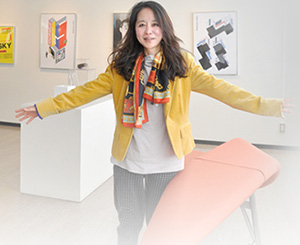 researcher, many times I feel like I’m falling behind. But, if there are advantages in losing one’s sense of direction as a postmodern dancer Steve Paxton says, I can only think about conducting a study in which I can utilize my own shortcomings.
researcher, many times I feel like I’m falling behind. But, if there are advantages in losing one’s sense of direction as a postmodern dancer Steve Paxton says, I can only think about conducting a study in which I can utilize my own shortcomings.
At present, I am planning to build personal networks with researchers from Germany, the United States, the United Kingdom, and Japan by participating in conferences including the International Congress on Aesthetics held in Poland this summer and an international symposium to be held in Saitama. As I engage in my main areas of study, which include translation of Shusterman’s work, I also intend to contribute to activities outside academia, such as helping bring to Japan Anna Halprin’s Planetary Dance (community dance calling for purification of land and peace).

A signature-collecting campaign for
reforming the Entertainment Business Act
started on May 29, 2012, with a goal to
collect 100,000 signatures.
Among various art fields, dance has held a relatively minor position. Especially in the world of aesthetics, which was established in the West in the modern era, and in the study of the arts which subsequently emerged—a world in which serious discourses on art are conducted—dance seems to be treated as a latecomer, compared with literature, music, and other fine arts. In the past, dance was subject to regulation by authorities and was considered rather unimportant as something enjoyed by women and children (or the masses or the uncivilized). Even now, dance may not be highly regarded, being deemed as part of recreation, social interaction, relaxation, (public) entertainment, and physical education.
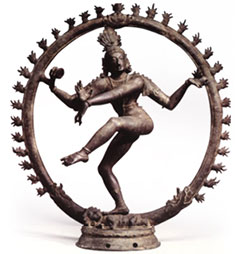
Shiva of Hinduism is also called Nataraja (lord of dance).
But at the same time, it is said that ancient dance is the mother of all arts. Nietzsche said, “I would only believe in a god who could dance.” Dance may embrace something that relates to the root of life and the dynamics of the universe. (“Disturbances” caused by the power of dance may still firmly exist in Japan, as seen in a ban based on the Entertainment Business Act, as well as schools making dance a required class like traditional martial arts.)
I served as organizing committee chair for the 63rd conference of the Japanese Society for Dance Research, which was held at the Sainokuni Saitama Arts Theater under the title, “Expansion of Dance: Halprin and Beyond.” Anna Halprin is a legend who gave inspiration to postmodern dance (“rebellious” dance in the United States in the 1960s) which went beyond the traditional framework of dance art. At the conference, participants learned from Halprin’s work, and Jamie McHugh, a practitioner of unique somatic techniques and an invitee to the conference, showed some of his methods. A workshop was also held at Saitama University, and the participants together with students had the opportunity to be exposed to the idea behind “expanded dance”—the idea that all people are dancers and that even the act of breathing or the
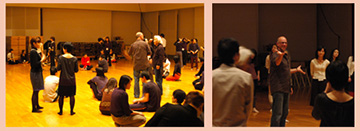
A workshop with Jamie McHugh held at the Sainokuni Saitama Arts Theater
state of no bodily motion can be dance.
Mr. McHugh’s regular workshop is held in the wilderness of Northern California. There, the participants experience the process of regaining their own voice and body by having direct contact with nature—the ocean, beach, rocks, light, and wind blowing through trees.

A workshop held in Northern California
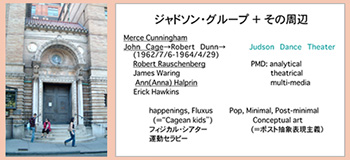
Judson Dance Theater and its context
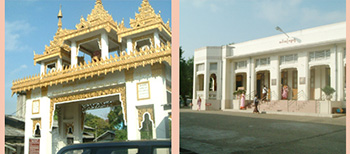
Mahasi Meditation Center in Yangon, Myanmar
Looking back the history of postmodern dance, one can see interactions with people outside of the field of dance such as Robert Rauschenberg and John Cage, the partner of Merce Cunningham (a pioneer of modern dance who parallels Halprin). From such interactions, a “democratic body” emerged, which did not ask about the participants’ skills in dance such as ballet or modern dance or about their special training or ability as a dancer.
Many people in modern dance showed their interest in somatic techniques and meditation methods that originated in Asia, such as those in Zen, yoga, tai chi, and aikido. Vipassana meditation, which I experienced at the Mahasi Meditation Center inMyanmar is also effective in becoming internally aware of minute sensations that the body generates and attaining a condition in which the body and mind become flexible and receptive.
I found beatnik poet Lawrence Ferlinghetti’s words in Hidehiko Mitomo’s website showcasing sticker art. I put them here as they suit the theme of my research.
I am thinking about the possible effects of dance by arbitrarily linking dance with the art of calming one’s soul through rituals of tamashizume (calming down soul) and tamafuri (reviving soul) in koshinto (ancient Shinto)—a combination of a force that pacifies an active mind and a force that breaks the old order of things.

Judson Memorial Church, Center of Postmodern
Dance, New York
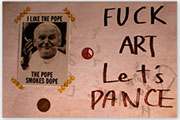
FUCK ART,
Let’s DANCE
Faculty of Liberal Arts (Liberal Arts Program, Philosophy and History Course)
Professor (aesthetics, art theory)
 The Prodigal Daughters Wouldn’t Come Home: Modernism and Postmodernism in American Dance (in Japanese). Tokyo: Keiso Shobo, 1999.
The Prodigal Daughters Wouldn’t Come Home: Modernism and Postmodernism in American Dance (in Japanese). Tokyo: Keiso Shobo, 1999.


© Copyright Saitama University, All Rights Reserved.